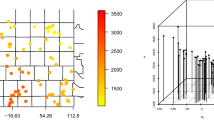This paper gives an overview of the existing approaches for modelling high quantiles of dependent spatial data and apply the methods to the bivariate circular case. We also adapt the bootstrap to the situation at hand.
Since any data set one might use is finite, the interest lies in estimating a continuous curve as its upper limit (or quantile function). This can be obtained by either a kernel type regression or a fitted parametric model. We also introduce a new, more realistic correction formula for a nonparametric method for estimating the pointwise maximum (called frontier in this setup [8]).
An additional common challenge in real-life applications is the dependence among subsequent observations. The theoretical results about the GPD limit of the exceedances beyond high threshold remain valid under mixing-type conditions, called D(un) in the extreme-value literature. However, if one intends to use the bootstrap-based reliability estimators, then they need to be adjusted — e.g., by the block-bootstrap approach in [15]. We estimate the reliability of the estimators by a suitable application of the m out of n bootstrap, which turned out to be suitable for high-quantile estimation.
We illustrate the introduced methods for simulated as well as real enzymes data.
Similar content being viewed by others
References
A.A. Balkema and L. de Haan, “Residual lifetime at great age,” Ann. Probab., 2, 792–804 (1974).
P. J. Bickel and A. Sakov, “On the choice of m in the m out of n bootstrap and confidence bounds for extrema,” Stat. Sinica, 18, 967–985 (2008).
Z. Cai, “Regression quantiles for time series,” Econ. Theor., 18, 169–192 (2002).
V. Chavez-Demoulin and A. C. Davison, “Generalized additive modelling of sample extremes,” Appl. Stat., 54, 207–222 (2005).
I.L. Dryden and K.V. Mardia, Statistical Shape Analysis: With Applications in R, Wiley, New York (2016).
I. L. Dryden and A. Zempléni, “Extreme shape analysis,” J. R. Stat. Soc. Ser. C, 55, No. 1, 103–121 (2006).
B. Efron, “Bootstrap methods: another look at the jackknife,” Ann. Stat., 7, 1–26 (1979).
S. Girarda and P. Jacob, “Frontier estimation via kernel regression on high power-transformed data,” J. Multivariate Anal., 99, 403–420 (2008).
P. Hall, The Bootstrap and Edgeworth Expansion, Springer, New York (1992).
S.N. Lahiri, Resampling Methods for Dependent Data, Springer, New York (2003).
M.R. Leadbetter, “Extremes and local dependence of stationary sequences,”Z. Wahrscheinlichkeitstheorie verw. Gebiete, 65, 291–306 (1983).
Q. Li, and J.S. Racine, “Nonparametric estimation of conditional CDF and quantile functions with mixed categorical and continuous data,” J. Bus. Econ. Stat., 26, 423–434 (2008).
Q. Li, J. Lin, and J.S. Racine, “Optimal bandwidth selection for nonparametric conditional distribution and quantile functions,” J. Bus. Econ. Stat., 31, 57–65 (2013).
E.A. Nadaraya, “On Estimating Regression,” Theor. Probab. Appl., 9, No. 1, 141–142 (1964).
D.N. Politis and H. White, “Automatic block-length selection for the dependent bootstrap,” Economet. Rev., 23, 53–70 (2004).
L. Varga and A. Zempléni, “Generalised block bootstrap and its use in meteorology,” Adv. Stat. Clim. Meteorol. Oceanogr., 3, 1–12 (2017).
X. Wang, C. van Eeden, and J. V. Zidek, “Asymptotic properties of maximum weighted likelihood estimators,” J. Stat. Plan. Infer., 119, 37–54 (2004).
G.S. Watson, “Smooth regression analysis,” Sankhy Ind. J. Stat., 26, No. 4, 359–372 (1964).
Author information
Authors and Affiliations
Corresponding author
Additional information
Proceedings of the XXXIV International Seminar on Stability Problems for Stochastic Models, Debrecen, Hungary.
Rights and permissions
About this article
Cite this article
Zempléni, A. Estimating High Quantiles Based on Dependent Circular Data. J Math Sci 237, 865–874 (2019). https://doi.org/10.1007/s10958-019-04213-0
Published:
Issue Date:
DOI: https://doi.org/10.1007/s10958-019-04213-0




